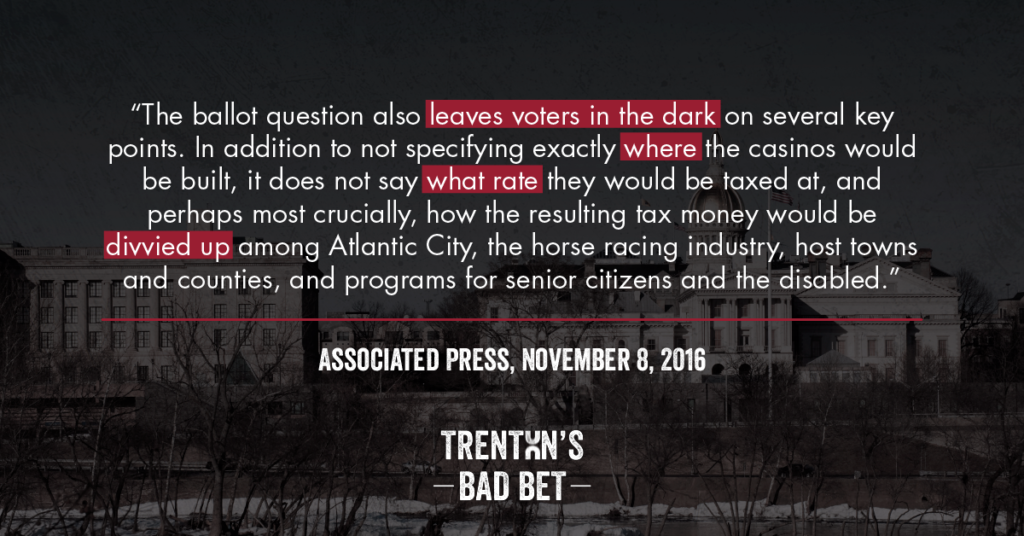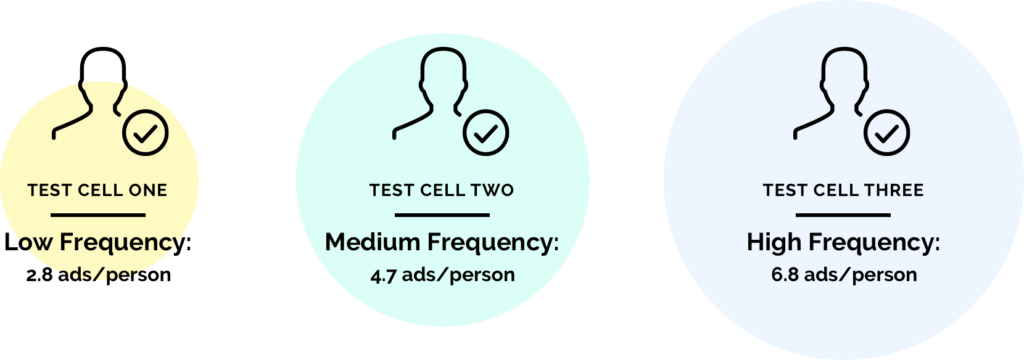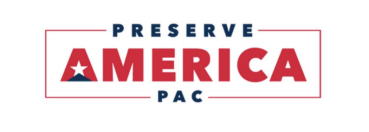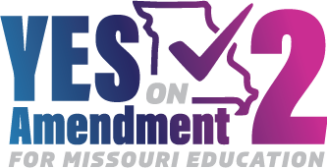About
FP1 Strategies is honored to have managed the Trenton’s Bad Bet campaign to stop the expansion of casino gambling in New Jersey.
We ran an integrated campaign from inception to Election Day that combined traditional coalition and grassroots strategies with earned media, digital communications, direct mail and a $10.5 million television and radio campaign in the New York City and Philadelphia media markets.
Our campaign was so successful that the proponents of casino expansion in North Jersey suspended their campaign in mid-September and the margin of defeat on Election Day was the largest for a referendum in state history. Jeff Gural, the owner of the Meadowlands and the leading funder of our opposition, Our Turn New Jersey, was quoted in the Wall Street Journal as saying that our campaign had a “brilliant strategy.”
Problem
Deep-pocketed developers were planning to spend $35 million to pass a ballot question in New Jersey to place two new casinos in the northern part of the state.
A June poll conducted by the widely-respected Monmouth University showed that the race was tied at 48 percent to 48 percent.
Our initial polling showed that 80 percent of New Jersey voters believed that their state economy was either in poor or merely fair shape. With the proponents of new casinos promising 40,000 new jobs and hundreds of millions in new tax revenue to help rebuild Atlantic City, we knew we had our work cut out for us.
Another challenge was the ballot language the Trenton politicians approved. It was clearly tilted to garner a “yes” vote and was full of declarations about how the new casinos would allocate funding to programs for seniors and the disabled and would help Atlantic City.
We had to be creative in our messaging and strategy development to overcome the ballot language, which essentially served as a government-funded persuasion campaign, and the anticipated media barrage from our opponents. We also had to finesse the fact that our campaign to stop casino expansion was funded by casino operators in New York and Atlantic City. Protecting the credibility of our messaging against casino expansion had to be handled delicately and intelligently.
Finally, the exorbitant cost of television advertising in the New York City media market upped the stakes for our creative team. We simply could not waste a dime on ads that did not move the dial. Every television ad had to count.
Solution
We conducted extensive polling of New Jersey voters to develop our strategy and messaging. Our research indicated that New Jersey voters had intense negative feelings about the politicians in Trenton.
81 percent of New Jerseyans believed that Trenton repeatedly broke their promises. This insight drove our entire campaign. Instead of running a campaign focused on the negative impacts of casino gambling on communities, we decided to run a campaign against the failures of Trenton politicians to keep their promises and how that lack of confidence was reflected in the ballot measure.
Voters were also strongly opposed to the fact that they would have no say on where the casinos would be built in North Jersey if the ballot question passed. 87 percent of voters said they should have the final say, not the politicians.
We also had a credible message that bringing new casinos to North Jersey would hurt the state’s economy. An independent study found that the proposed casinos would have a devastating impact on the economies of Atlantic City and South Jersey, inflicting $2 billion in economic losses and destroying 30,000 jobs. We decided to put millions of dollars behind this message, as 74 percent of voters in our initial poll said this information made them more likely to vote against gambling expansion.
Therefore, the sequencing of the message commenced with the narrative against Trenton and followed with the economic points, which voters ultimately found very convincing.
Media Campaign
Armed with the findings of our polling data, we developed a media plan and advertising strategy to win the campaign. Our first step was to conduct a micro-targeting survey informed by the benchmark polling conducted at the outset of the effort.
Next, we applied data analytics to target our television advertising. This stretched every dollar and drove down the cost of advertising in the New York City media market by ensuring more lead was on target. We partnered with a data analytics firm, Deep Root Analytics, and targeted both voters who were opposed to the ballot initiative and those we could persuade. This data-driven approach to television buying allowed us to burn in two ads in the New York City market for the cost of one ad using traditional buying models. These efficiencies allowed us to go on the air in the New York City media market in August and stay up through Election Day, driving the narrative of the campaign and forcing our opposition to suspend their own advertising campaign.
The first ad of the campaign, “Risky Bet,” established the frame for the race by reminding voters that Trenton politicians had repeatedly broken their promises on big issues, like property taxes and pensions, while informing voters that there were no specifics on where the new casinos would be located.
Digital Campaign
As part of a statewide effort to block New Jersey Public Question One from expanding casino gambling outside of Atlantic City, https://trentonsbadbet.org/ was built to serve as the central digital hub for all updates on the Trenton’s Bad Bet campaign, including press releases, endorsements and news surrounding our efforts.
Branded with the font, colors and animations that came to define our overall online presence, the website’s design, functionality and content enhanced our message that behind the glitz of casinos was a dark side. Our campaign endeavored to expose the negative impact casino expansion would have on the state’s jobs, families and economy – and the website mirrored that goal with its shadowy imagery, dark branding and messaging. The website served as the linchpin for a robust digital advertising campaign that complemented aggressive television and mail efforts.

The “Frequently Asked Questions” section served as a centerpiece to our message that voters “Can’t Trust Trenton.”
The site also supported our prolific social media presence, included robust landing page functionality and focused on driving voter action with an integrated action center.
This website was a central part of a robust digital advertising effort that generated 288,577 page views on key messaging that, as part of an integrated campaign, drove 78 percent of voters to vote in our favor, defeating the ballot initiative by the largest margin in state history.

In addition, the full-scale persuasion campaign needed to effectively change voter opinion required advertising in both the New York City and Philadelphia media markets, which meant that strategic digital advertising and the coalition’s overall online presence had to play a crucial role, to complement more expensive and less-tightly targeted traditional persuasion efforts, like television and mail.
Specifically, these digital advertising efforts needed to be effectively targeted at a variety of key voting audiences while maximizing a limited budget. They also had to be focused on audience-based messages directed at politicians and the press, left-leaning women and voters in northern New Jersey, among other key demographics.
In an effort ensure our digital targeting could better shift voter perception on the ballot question, we partnered with Facebook to conduct a weight of message study over a two-week period before the election to measure the impact of ad frequency.
To do this, we produced two video ads highlighting the negative impact of approving the ballot initiative and ran both creatives to three test cells:

The study’s goal was to determine what frequency (media weight) across multiple voter audiences was most effective at moving voter intent against the ballot initiative we were fighting to stop, thus enabling us to focus in on the most persuadable audiences through constant testing.
The results of this test showed by a statistically significant measure that the high frequency treatment had the most impact in moving viewers in our favor.
Additionally, the high frequency treatment had a statistically significant impact on the following subgroups versus the control group:

These findings allowed us to sharpen our online approach and, when coupled with additional targeting tactics, helped ensure our messages were being served at the most effective frequency to shift voter perception. This allowed us to move the needle in our favor, driving voters to oppose the ballot question while also ensuring cost savings so we could effectively spend in other areas. Thanks to this testing, we served effective online messages beyond traditional television and mail to core persuadable audiences while ensuring a notable shift in opinion.
While time spent consuming television still leads other mediums, as recently as June 2016, 25 percent of American households were found to no longer have paid television service.
These changing trends presented us with a clear problem as marketers attempting to persuade voters: How do we get our message in front of voters that our television ads no longer reach? And on the other hand, how do we find those voters who are already exposed to our television advertising and make sure we do not bombard them with digital advertising?
To address this, we teamed up with Deep Root Analytics, whose offerings provide a vast trove of voters’ television consumption habits. This data helped us reach New Jersey voters online that our television ads were missing.
Once these audiences were identified and brought online, we created a specific audience representing 282,000 voters within our target universe and layered on additional ads to them that our television advertising efforts were not able to provide. This resulted in 900,000 additional ads served.

Overall, the numbers speak for themselves: 47 million digital ad impressions, 40 million video views, 39 million completed views, 170,000 click-throughs, 639 organic tweets and 466 organic Facebook posts.
These efforts secured three Reed Awards: Best Ad for Ballot Initiative for “Einstein,” Best Web Video for Ballot Initiative – Republican for “Popcorn” and Best Use of Online Targeting for Ballot Initiative – Republican for our Cord Cutting and Frequency Tests.
Earned Media
We ran an aggressive earned media campaign to place op-eds from community leaders, drive story lines in the New Jersey, New York and Philadelphia media, obtain third-party validation with endorsements from both sides of the political spectrum and secure the support of editorial boards around the state. Our earned media efforts dovetailed with our paid advertising to keep Our Turn NJ on their heels the entire campaign.
We conducted extensive polling of New Jersey voters to develop our strategy and messaging. Our research indicated that New Jersey voters had intense negative feelings about the politicians in Trenton.
81 percent of New Jerseyans believed that Trenton repeatedly broke their promises. This insight drove our entire campaign. Instead of running a campaign focused on the negative impacts of casino gambling on communities, we decided to run a campaign against the failures of Trenton politicians to keep their promises and how that lack of confidence was reflected in the ballot measure.
Voters were also strongly opposed to the fact that they would have no say on where the casinos would be built in North Jersey if the ballot question passed. 87 percent of voters said they should have the final say, not the politicians.
We also had a credible message that bringing new casinos to North Jersey would hurt the state’s economy. An independent study found that the proposed casinos would have a devastating impact on the economies of Atlantic City and South Jersey, inflicting $2 billion in economic losses and destroying 30,000 jobs. We decided to put millions of dollars behind this message, as 74 percent of voters in our initial poll said this information made them more likely to vote against gambling expansion.
Therefore, the sequencing of the message commenced with the narrative against Trenton and followed with the economic points, which voters ultimately found very convincing.
Media Campaign
Armed with the findings of our polling data, we developed a media plan and advertising strategy to win the campaign. Our first step was to conduct a micro-targeting survey informed by the benchmark polling conducted at the outset of the effort.
Next, we applied data analytics to target our television advertising. This stretched every dollar and drove down the cost of advertising in the New York City media market by ensuring more lead was on target. We partnered with a data analytics firm, Deep Root Analytics, and targeted both voters who were opposed to the ballot initiative and those we could persuade. This data-driven approach to television buying allowed us to burn in two ads in the New York City market for the cost of one ad using traditional buying models. These efficiencies allowed us to go on the air in the New York City media market in August and stay up through Election Day, driving the narrative of the campaign and forcing our opposition to suspend their own advertising campaign.
The first ad of the campaign, “Risky Bet,” established the frame for the race by reminding voters that Trenton politicians had repeatedly broken their promises on big issues, like property taxes and pensions, while informing voters that there were no specifics on where the new casinos would be located.
Digital Campaign
As part of a statewide effort to block New Jersey Public Question One from expanding casino gambling outside of Atlantic City, https://trentonsbadbet.org/ was built to serve as the central digital hub for all updates on the Trenton’s Bad Bet campaign, including press releases, endorsements and news surrounding our efforts.
Branded with the font, colors and animations that came to define our overall online presence, the website’s design, functionality and content enhanced our message that behind the glitz of casinos was a dark side. Our campaign endeavored to expose the negative impact casino expansion would have on the state’s jobs, families and economy – and the website mirrored that goal with its shadowy imagery, dark branding and messaging. The website served as the linchpin for a robust digital advertising campaign that complemented aggressive television and mail efforts.

The “Frequently Asked Questions” section served as a centerpiece to our message that voters “Can’t Trust Trenton.”
The site also supported our prolific social media presence, included robust landing page functionality and focused on driving voter action with an integrated action center.
This website was a central part of a robust digital advertising effort that generated 288,577 page views on key messaging that, as part of an integrated campaign, drove 78 percent of voters to vote in our favor, defeating the ballot initiative by the largest margin in state history.

In addition, the full-scale persuasion campaign needed to effectively change voter opinion required advertising in both the New York City and Philadelphia media markets, which meant that strategic digital advertising and the coalition’s overall online presence had to play a crucial role, to complement more expensive and less-tightly targeted traditional persuasion efforts, like television and mail.
Specifically, these digital advertising efforts needed to be effectively targeted at a variety of key voting audiences while maximizing a limited budget. They also had to be focused on audience-based messages directed at politicians and the press, left-leaning women and voters in northern New Jersey, among other key demographics.
In an effort ensure our digital targeting could better shift voter perception on the ballot question, we partnered with Facebook to conduct a weight of message study over a two-week period before the election to measure the impact of ad frequency.
To do this, we produced two video ads highlighting the negative impact of approving the ballot initiative and ran both creatives to three test cells:

The study’s goal was to determine what frequency (media weight) across multiple voter audiences was most effective at moving voter intent against the ballot initiative we were fighting to stop, thus enabling us to focus in on the most persuadable audiences through constant testing.
The results of this test showed by a statistically significant measure that the high frequency treatment had the most impact in moving viewers in our favor.
Additionally, the high frequency treatment had a statistically significant impact on the following subgroups versus the control group:

These findings allowed us to sharpen our online approach and, when coupled with additional targeting tactics, helped ensure our messages were being served at the most effective frequency to shift voter perception. This allowed us to move the needle in our favor, driving voters to oppose the ballot question while also ensuring cost savings so we could effectively spend in other areas. Thanks to this testing, we served effective online messages beyond traditional television and mail to core persuadable audiences while ensuring a notable shift in opinion.
While time spent consuming television still leads other mediums, as recently as June 2016, 25 percent of American households were found to no longer have paid television service.
These changing trends presented us with a clear problem as marketers attempting to persuade voters: How do we get our message in front of voters that our television ads no longer reach? And on the other hand, how do we find those voters who are already exposed to our television advertising and make sure we do not bombard them with digital advertising?
To address this, we teamed up with Deep Root Analytics, whose offerings provide a vast trove of voters’ television consumption habits. This data helped us reach New Jersey voters online that our television ads were missing.
Once these audiences were identified and brought online, we created a specific audience representing 282,000 voters within our target universe and layered on additional ads to them that our television advertising efforts were not able to provide. This resulted in 900,000 additional ads served.

Overall, the numbers speak for themselves: 47 million digital ad impressions, 40 million video views, 39 million completed views, 170,000 click-throughs, 639 organic tweets and 466 organic Facebook posts.
These efforts secured three Reed Awards: Best Ad for Ballot Initiative for “Einstein,” Best Web Video for Ballot Initiative – Republican for “Popcorn” and Best Use of Online Targeting for Ballot Initiative – Republican for our Cord Cutting and Frequency Tests.
Earned Media
We ran an aggressive earned media campaign to place op-eds from community leaders, drive story lines in the New Jersey, New York and Philadelphia media, obtain third-party validation with endorsements from both sides of the political spectrum and secure the support of editorial boards around the state. Our earned media efforts dovetailed with our paid advertising to keep Our Turn NJ on their heels the entire campaign.
Results
On Election Day, New Jersey voters rejected Question One by a margin of 78 percent to 22 percent, the largest defeat for a ballot question in New Jersey history.
This result is a testament to what our opponents repeatedly called a “brilliant strategy” and the precise execution of that strategy across several different communications media. In delivering such a stinging defeat to the North Jersey casinos, we have made it considerably less likely that Trenton politicians will attempt to expand gambling in New Jersey again. The voters have spoken and their will is clear – they do not want more casinos in New Jersey.
On Election Day, New Jersey voters rejected Question One by a margin of 78 percent to 22 percent, the largest defeat for a ballot question in New Jersey history.
This result is a testament to what our opponents repeatedly called a “brilliant strategy” and the precise execution of that strategy across several different communications media. In delivering such a stinging defeat to the North Jersey casinos, we have made it considerably less likely that Trenton politicians will attempt to expand gambling in New Jersey again. The voters have spoken and their will is clear – they do not want more casinos in New Jersey.
Recent Case Studies

FP1 is proud to have served as the media consultant to Preserve America PAC’s IE, which invested more than $100 million to help President Trump win the “Blue Wall” states of Pennsylvania, Wisconsin and Michigan.
Case Study
FP1 is proud to have served as the media consultant for Tim Sheehy’s U.S. Senate campaign, helping this decorated Navy SEAL defeat a three-term Democratic incumbent.
Case Study
FP1 is proud to have served as the media consultant for Winning for Missouri Education’s campaign to pass Amendment 2, which legalized sports betting in Missouri and will generate more than $100 million for schools over the next five years.
Case Study